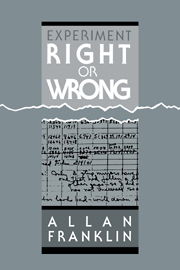Book contents
- Frontmatter
- Contents
- Preface
- Acknowledgments
- Introduction
- I EXPERIMENT AND THE DEVELOPMENT OF THE THEORY OF WEAK INTERACTIONS: FROM FERMI TO V-A
- 1 Fermi's theory
- 2 Toward a universal Fermi interaction; muons and pions
- 3 Beta-decay theory following World War II
- 4 The discovery of parity nonconservation
- 5 The V-A theory of weak interactions and its acceptance
- II TOWARD A PHILOSOPHY OF EXPERIMENT
- Conclusion
- Appendix
- References
- Index
4 - The discovery of parity nonconservation
Published online by Cambridge University Press: 15 September 2009
- Frontmatter
- Contents
- Preface
- Acknowledgments
- Introduction
- I EXPERIMENT AND THE DEVELOPMENT OF THE THEORY OF WEAK INTERACTIONS: FROM FERMI TO V-A
- 1 Fermi's theory
- 2 Toward a universal Fermi interaction; muons and pions
- 3 Beta-decay theory following World War II
- 4 The discovery of parity nonconservation
- 5 The V-A theory of weak interactions and its acceptance
- II TOWARD A PHILOSOPHY OF EXPERIMENT
- Conclusion
- Appendix
- References
- Index
Summary
In late 1956 and early 1957 the situation changed dramatically. Following a suggestion by Lee and Yang (1956) that parity, or mirror symmetry, might be violated in the weak interactions, which included β decay, a series of experiments by Wu and her collaborators (1957), by Garwin, Lederman, and Weinrich (1957), and by Friedman and Telegdi (1957a) showed conclusively that this was the case. This discovery had serious implications for the previous analyses of β decay, suggested new experiments, and pointed the way toward a new theory of β decay.
We can summarize the history of this discovery as follows. During the 1950s the physics community was faced with what was known as the “θ–τ puzzle.” On one set of accepted criteria, that of identical masses and lifetimes, the θ and τ particles appeared to be the same particle. On another set of accepted criteria, that of spin and parity, they appeared to be different. The spin and parity analysis was performed on the decay products, two pions for the θ and three pions for the τ. Parity conservation was assumed in these decays and the spin and parity of the θ and τ were inferred. There were several attempts to solve this puzzle within the framework of currently accepted theories, but all of these were unsuccessful.
In 1956, Lee and Yang recognized that a possible solution to the problem would be the nonconservation of parity in the weak interactions.
- Type
- Chapter
- Information
- Experiment, Right or Wrong , pp. 63 - 74Publisher: Cambridge University PressPrint publication year: 1990



